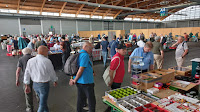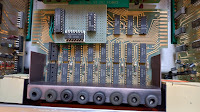 |
| Hall A4 at 1/3 capacity at 9:18 day 1 |
Space usage was pretty much the same of last year, as I had documented for my future self on this blog. The crowd was more or less the same. We stayed from 09:15 to 15:30 on day 1, Friday.
Regardless of the shrinking (or not) of sellers and audience, Ham Messe is still unique as it gathers HAMs from all over Europe and the world.
What I bought:
- an energy measuring device for home (5 €)
- 8 sticks of machined pin sockets and 2 sticks of multiturn Bourns trimpots (2 €/stick)
- two Z303C dekatrons (10 €)
- a variable lab power supply with 8V, 18V, 80V independent outputs (25 €)
- T-shaped BNC adapters to play with the HP counter (1 €/each)
What I haven't bought:
- an HP signal generator "for parts" (probably working) we couldn't reach an agreement on the price
- other gear that I saw leaving the hall at lunch time, I think withdrawn from owners not actually sold!
- Nixie tubes at current market price
- what looked like homemade HF RTX from HA and YU sellers, since I have no HF antenna at home
- other aero DME receivers that I bought last years, too bad
That's it. Next year the Ham Messe will be held on 28-30 June, 2024, if it will take place.
Three more pictures.
 |
| Pretty early days vacuum tubes... |
 |
| ... quite recent lab instruments. |
 |
| I didn't know of this initiative from the nearby city Tettnang. |



